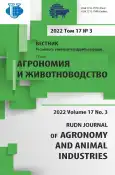Динамика показателей спинномозговой жидкости в послеоперационный период при коррекции дегенеративного пояснично-крестцового стеноза у собак
- Авторы: Вилковыский И.Ф.1
-
Учреждения:
- Российский университет дружбы народов
- Выпуск: Том 17, № 3 (2022)
- Страницы: 382-391
- Раздел: Ветеринария
- URL: https://journal-vniispk.ru/2312-797X/article/view/315634
- DOI: https://doi.org/10.22363/2312-797X-2022-17-3-382-391
- ID: 315634
Цитировать
Полный текст
Аннотация
Динамика показателей спинномозговой жидкости в послеоперационный период при коррекции дегенеративного пояснично-крестцового стеноза у собак представляет собой важный диагностический аспект, позволяющий осуществлять контроль над изменением состояния животных после хирургического вмешательства. Точный анализ спинномозговой жидкости дает широкий спектр информации о неврологическом здоровье пациента. Оценка должна состоять из макроскопического, количественного и микроскопического анализов. Количество клеток является наиболее важным и потенциально чувствительным индикатором заболевания. Целью данного исследования было определение изменений в спинномозговой жидкости в течение послеоперационного периода при коррекции дегенеративного пояснично-крестцового стеноза. В исследовании было 9 собак различных пород, в возрасте от 2 до 8 лет (опытная группа), в качестве контроля использовали показатели ликвора и периферической крови 3 здоровых беспородных собак полученных в результате диспансеризации в возрасте до 5 лет. Хирургическое вмешательство осуществляли по методу Б.П. Меий, Н. Бергкнут, заключающемуся в дорсальном доступе к дужкам позвонков L7-S 1, диссекции мягких тканей, рассечении дорсальной связки, формировании каналов в краниальных суставных отростках S 1, L7. От каждого животного трижды отбирали на исследование по три ликворограммы на 1-3-и сутки после операции, на 12-15-е и 27-30-е сутки после оперативного вмешательства. Исследование ликвора выполняли в течении 30 мин после взятия. В результате установлено, что клеточный состав ликвора собак в послеоперационный период коррекции пояснично-крестцового стеноза находился в пределах физиологической нормы, эритроциты в ликворе не были обнаружены. Количество ядросодержащих клеток у прооперированных собак было наибольшим в 1-3-и сутки после операции. На 12-15-е сутки цитоз в опытной и контрольной группе животных был больше на 1,17 кл/мкл. На 27-30-е сут после операции цитоз у собак в опытной группе был ниже, чем в контроле на 0,43 кл/мкл. Анализ спинномозговой жидкости может помочь в диагностической оценке состояния животных в постоперационный период. Однако следует учитывать, что результаты редко бывают специфичными для какого-либо конкретного состояния и должны интерпретироваться в свете клинических и дополнительных диагностических данных.
Об авторах
Илья Федорович Вилковыский
Российский университет дружбы народов
Автор, ответственный за переписку.
Email: vilkovyskiy-if@rudn.ru
ORCID iD: 0000-0003-0084-6383
кандидат ветеринарных наук, доцент, доцент департамента ветеринарной медицины аграрно-технологического института
Российская Федерация, 117198, Москва, ул. Миклухо-Маклая, д. 6Список литературы
- Braund KG. Clinical neurology in small animal: localization, diagnosis and treatment. In: Braund, K.G. (ed.). Ithaca, New York: International Veterinary Information Service; 2003.
- Pino MG, Ganguly R, Rich KA, Fox A, Mattox L, Keckley E, et al. Continual cerebrospinal fluid sampling in the neonatal domestic piglet for biomarker and discovery studies. Journal of Neuroscience Methods. 2022; 366:109403. doi: 10.1016/j.jneumeth.2021.109403
- Vatnikov YA, Rotanov DA, Bazhibina EB. Analysis of structure and function of dogs’ erythrocytes with trauma. Veterinary medicine. 2007; (2):44-48. (In Russ.).
- Vatnikov YA. Immunokorrektsiya reparativnogo osteogeneza u eksperimental’nykh zhivot-nykh [Immunocorrection of reparative osteogenesis in experimental animals]. Moscow: RUDN publ.; 2009. (In Russ.).
- Vatnikov YA. Characteristics of hematopoiesis in multiple injuries in dogs. Veterinary pathology. 2012; (4):45-48. (In Russ.).
- Terlizzi RD, Platt SR. The function, composition and analysis of cerebrospi-nal fluid in companion animals: Part II-Analysis. The Veterinary Journal. 2009; 180(1):15-32. doi: 10.1016/j.tvjl.2007.11.024
- Moissonnier P, Blot S, Devauchelle P, Delisle F, Beuvon F, Boulha L, et al. Stereotactic CT-guided brain biopsy in the dog. J Small Anim Prac. 2002; 43(3):115-123. doi: 10.1111/j.1748-5827.2002.tb00041.x
- Craven CL, Asif H, Curtis C, Thompson SD, D’Antona L, Ramos J, et al. Interpretation of lumbar cerebrospinal fluid leukocytosis after cranial surgery: The relevance of aseptic meningitis. Journal of Clinical Neuroscience. 2020; 76:15-19. doi: 10.1016/j.jocn.2020.04.077
- Meij BP, Bergknut N. Degenerative lumbosacral stenosis in dogs. Veterinary Clinics of North America: Small Animal Practice. 2010; 40(5):983-1009. doi: 10.1016/j.cvsm.2010.05.006
- Rusbridge C. Collection and interpretation of cerebrospinal fluid in cats and dogs. In Practice. 1997; 19(6):322-331. doi: 10.1136/inpract.19.6.322
- Mayhew PD, Kapatkin AS, Wortman JA, Vite CH. Association of cauda equina compression on magnetic resonance images and clinical signs in dogs with degenerative lumbosacral stenosis. J Am Anim Hosp Assoc. 2002; 38(6):555-562. doi: 10.5326/0380555
- Modic MT, Ross JS. Lumbar degenerative disk disease. Radiology. 2007; 245(1):43-61. doi: 10.1148/radiol.2451051706
- Floman Y, Wiesel SW, Rothman RH. Cauda equine syndrome presenting as a herniated lumbar disk. Clin Orthop Rel Res. 1980; 147:234-237.
- Jaradeh S. Cauda equina syndrome: a neurologist’s perspective. Regional Anesthesia and Pain Medicine. 1993; 18:473-480.
- Suwankong N, Meij BP, Voorhout G, de Boer AH, Hazewinkel HAW. Review and retrospective analysis of degenerative lumbosacral stenosis in 156 dogs treated by dorsal laminectomy. Vet Comp Orthop Traumatol. 2008; 21(3):285-293. doi: 10.1055/s-0037-1617374
- Jeffery ND, Barker A, Harcourt-Brown T. What progress has been made in the understanding and treatment of degenerative lumbosacral stenosis in dogs during the past 30 years? The Veterinary Journal. 2014; 201(1):9-14. doi: 10.1016/j.tvjl.2014.04.018
Дополнительные файлы










